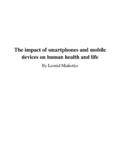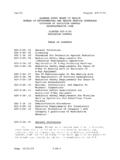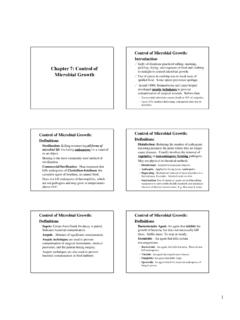Transcription of Depleted uranium: sources, exposure and health …
1 1 Depleted uranium : sources, exposure and health effects Executive summaryThis scientific review on Depleted uranium is part of the world health organization 's (WHO's)ongoing process of assessment of possible health effects of exposure to chemical, physical andbiological agents. Concerns about possible health consequences to populations residing inconflict areas where Depleted uranium munitions were used have raised many importantenvironmental health questions that are addressed in this and scopeThe main purpose of the monograph is to examine health risks that could arise from exposureto Depleted uranium . The monograph is intended to be a desk reference providing usefulinformation and recommendations to WHO Member States so that they may deal appropriatelywith the issue of Depleted uranium and human is given on sources of Depleted uranium exposure , the likely routes of acute andchronic intake, the potential health risks from both the radiological and chemical toxicitystandpoints and future research needs.
2 Several ways of uptake of compounds with widelydifferent solubility characteristics are also about uranium is used extensively because it behaves in the body the same wayas Depleted and Depleted uraniumUranium is a naturally occurring, ubiquitous, heavy metal found in various chemical forms inall soils, rocks, seas and oceans. It is also present in drinking water and food. On average,approximately 90 g (micrograms) of uranium exist in the human body from normal intakesof water, food and air; approximately 66% is found in the skeleton, 16% in the liver, 8% in thekidneys and 10% in other uranium consists of a mixture of three radioactive isotopes which are identified by themass numbers 238U( by mass), 235U( ) and 234U( ). uranium is used primarily in nuclear power plants; most reactors require uranium in which the235U content is enriched from to about 3%. The uranium remaining after removal of theenriched fraction is referred to as Depleted uranium .
3 Depleted uranium typically contains 238U, 235U and 234U by the same mass, Depleted uranium has about 60% of the radioactivity of uranium may also result from the reprocessing of spent nuclear reactor fuel. Underthese conditions another uranium isotope, 236U may be present together with very smallamounts of the transuranic elements plutonium, americium and neptunium and the fissionproduct technetium-99. The increase in the radiation dose from the trace amounts of theseadditional elements is less than 1%. This is insignificant with respect to both chemical andradiological of Depleted uraniumDepleted uranium has a number of peaceful applications: counterweights or ballast in aircraft,radiation shields in medical equipment used for radiation therapy and containers for thetransport of radioactive to its high density, which is about twice that of lead, and other physical properties, Depleted uranium is used in munitions designed to penetrate armour plate.
4 It also reinforcesmilitary vehicles, such as and exposure pathways2 Individuals can be exposed to Depleted uranium in the same way they are routinely exposedto natural uranium , by inhalation, ingestion and dermal contact (including injury byembedded fragments).Inhalation is the most likely route of intake during or following the use of Depleted uraniummunitions in conflict or when Depleted uranium in the environment is re-suspended in theatmosphere by wind or other forms of disturbance. Accidental inhalation may also occur as aconsequence of a fire in a Depleted uranium storage facility, an aircraft crash or thedecontamination of vehicles from within or near conflict could occur in large sections of the population if their drinking water or food becamecontaminated with Depleted uranium . In addition, the ingestion of soil by children is alsoconsidered a potentially important contact is considered a relatively unimportant type of exposure since little of thedepleted uranium will pass across the skin into the blood.
5 However, Depleted uranium couldenter the systemic circulation through open wounds or from embedded Depleted retentionMost (>95%) uranium entering the body is not absorbed, but is eliminated via the faeces. Ofthe uranium that is absorbed into the blood, approximately 67% will be filtered by the kidneyand excreted in the urine in 24 between and 2% of the uranium in food and water is absorbed by thegastrointestinal tract. Soluble uranium compounds are more readily absorbed than those whichare effectsPotentially Depleted uranium has both chemical and radiological toxicity with the two importanttarget organs being the kidneys and the lungs. health consequences are determined by thephysical and chemical nature of the Depleted uranium to which an individual is exposed, andto the level and duration of studies of workers exposed to uranium have reported some impairment of kidneyfunction depending on the level of exposure .
6 However, there is also some evidence that thisimpairment may be transient and that kidney function returns to normal once the source ofexcessive uranium exposure has been inhaled uranium particles, 1-10 m in size, tend to be retained in the lung and maylead to irradiation damage of the lung and even lung cancer if a high enough radiation doseresults over a prolonged contact of Depleted uranium metal with the skin, even for several weeks, is unlikely toproduce radiation-induced erythema (superficial inflammation of the skin) or other short termeffects. Follow-up studies of veterans with embedded fragments in the tissue have showndetectable levels of Depleted uranium in the urine, but without apparent health radiation dose to military personnel within an armoured vehicle is very unlikely to exceedthe average annual external dose from natural background radiation from all on chemical toxicity and radiological doseThe monograph gives for the different types of exposure the tolerable intake, an estimate ofthe intake of a substance that can occur over a lifetime without appreciable health risk.
7 Thesetolerable intakes are applicable to long term exposure . Single and short term exposures tohigher levels may be tolerated without adverse effects but quantitative information is notavailable to assess how much the long term tolerable intake values may be temporarilyexceeded without general public s ingestion of soluble uranium compounds should not exceed the tolerableintake of g per kg of body weight per day. Insoluble uranium compounds are markedly3less toxic to the kidneys, and a tolerable intake of 5 g per kg of body weight per day of soluble or insoluble Depleted uranium compounds by the public should not exceed1 g/m3 in the respirable fraction. This limit is derived from renal toxicity for soluble uraniumcompounds, and from radiation exposure for insoluble uranium worker exposure to Depleted uranium via ingestion is unlikely in workplaces whereoccupational health measures are in exposure to soluble and insoluble uranium compounds, as an 8-hour timeweighted average should not exceed mg/m3.
8 This limit is also based both on chemicaleffects and radiation dose limitsRadiation dose limits are prescribed for exposures above natural background occupational exposure , the effective dose should not exceed 20 millisieverts (mSv) per yearaveraged over five consecutive years, or an effective dose of 50 mSv in any single year. Theequivalent dose to the extremities (hands and feet) or the skin should not exceed 500 mSv ina exposure of the general public the effective dose should not exceed 1 mSv in a year; inspecial circumstances, the effective dose can be limited to 5 mSv in a single year provided thatthe average dose over five consecutive years does not exceed 1 mSv per year. The equivalentdose to the skin should not exceed 50 mSv in a of intake and treatmentFor the general population it is unlikely that the exposure to Depleted uranium will significantlyexceed the normal background uranium levels.
9 When there is a good reason to believe that anexceptional exposure has taken place, the best way to verify this is to measure uranium in intake of Depleted uranium can be determined from the amounts excreted daily in uranium levels are determined using sensitive mass spectrometric techniques; in suchcircumstances it should be possible to assess doses at the mSv monitoring can give useful information on intake if samples are collected soon radiation monitoring of the chest is of limited application because it requires the useof specialist facilities, and measurements need to be made soon after exposure for the purposeof dose assessment. Even under optimal conditions the minimum doses that can be assessedare in the tens of is no suitable treatment for highly exposed individuals that can be used to appreciablyreduce the systemic content of Depleted uranium when the time between exposure andtreatment exceeds a few hours.
10 Patients should be treated based on the symptoms : EnvironmentOnly military use of Depleted uranium is likely to have any significant impact on environmentallevels. Measurements of Depleted uranium at sites where Depleted uranium munitions wereused indicate only localized (within a few tens of metres of the impact site) contamination atthe ground surface. However, in some instances the levels of contamination in food and groundwater could rise after some years and should be monitored and appropriate measures takenwhere there is a reasonable possibility of significant quantities of Depleted uranium entering thefood chain. The WHO guidelines for drinking-water quality, 2 g of uranium per litre, wouldapply to Depleted possible clean-up operations in conflict impact zones should be undertaken where thereare substantial numbers of radioactive particles remaining and Depleted uranium contaminationlevels are deemed unacceptable by qualified experts.
















